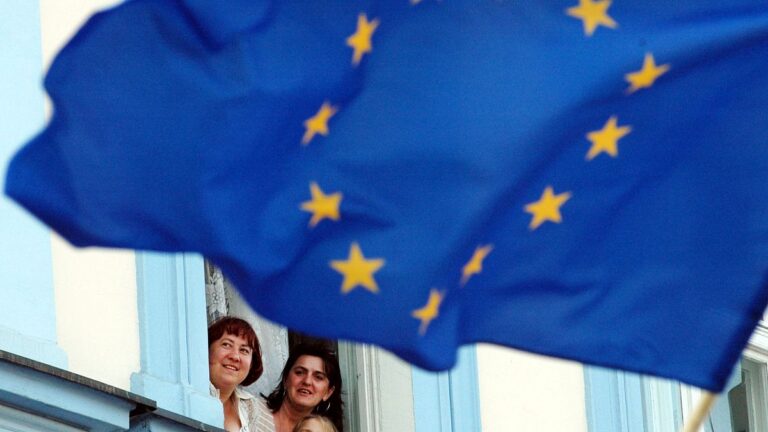The origins of this anniversary date back to 1950, when Europe was still recovering from the devastation of World War II.
advertisement
Every year on May 9, Europeans celebrate Europe Day, a commemoration that honours the beginning of the continent’s political and economic integration and the lasting peace achieved as a result of decades of joint effort.
The celebration dates back to 1950, when then-French Foreign Minister Robert Schuman issued a landmark declaration proposing that France and Germany, two countries with a long and bloody history, combine their coal and steel production.
In doing so, Schuman intended to accelerate the modernization of both countries while eliminating incentives that could foster unfair competition after the economic devastation and human carnage caused by World War II.
By intimately intertwining these vital industries, the French minister set himself the loftier aim of making war impractical and futile.
“The solidarity of production thus established will make it clear that any war between France and Germany is not merely unthinkable but physically impossible,” Schumann said, reading the declaration at the Salon des Horloges on the Quai d’Orsay in Paris on May 9, 1950.
Schuman wisely left the door open for other nations to join in and achieve a truly united Europe, an ambition pursued during the interwar period that collapsed under the weight of national interests.
Schuman’s proposal was successful, and West German Chancellor Konrad Adenauer agreed almost immediately.
Slowly a unified Europe was born.
A year later, on 18 April 1951, representatives from France, Germany, Italy, Belgium, the Netherlands and Luxembourg signed the Treaty of Paris, establishing the European Coal and Steel Community (ECSC), a pioneering organisation based on supranationalist principles.
Under the ECSC, nation-states accepted the transfer of their closely guarded sovereign powers to a set of newly established European institutions, such as an independent higher authority, a common parliament of national parliamentarians, a special council of national ministers, and a Court of Justice.
Jean Monnet, a close aide to Schuman and now considered the driving force behind the landmark declaration, was appointed the first president of the supreme body.
The economic benefits of the ECSC, such as the tariff-free market that stimulated trade in coal and steel, led member states to decide to go further than the original blueprint and bring more sectors and policy areas under supranational competence.
The ECSC gradually evolved, first into the European Economic Community and then into the European Union.
The original four institutions eventually evolved into what we know today: the European Commission, the European Parliament, the Council of the EU, and the European Court of Justice.
With its steady transformation of a political project the likes of which humanity had never seen before, the Schuman Declaration cemented its status as the true origins of European integration.
“Europe will not be built all at once, nor according to a single plan. It will be built first and foremost through concrete achievements that create a de facto sense of solidarity,” the French politician said in his speech.
At a conference held in Milan in 1985, heads of state and government decided to officially name May 9th Europe Day to celebrate peace and unity on the European continent.
The event has become one of the main symbols of the European Union, with its flag with 12 stars, the slogan “In varietate concordia” (United in diversity) and a national anthem based on Beethoven’s “Ode to Joy.”
The 2004 European Constitutional Treaty intended to incorporate these symbols as the official emblems of the European Union, but this provision was removed when the ratification process failed.
advertisement
Interestingly, Europe Day is only celebrated as a national holiday in two countries: Luxembourg, where Schuman was born in 1886, and Kosovo, a non-EU country that has long sought to join the EU. In Romania, it coincides with Independence Day, while Croatia and Lithuania have legally recognised Europe Day but do not make it a national holiday.
Other member states mark Europe Day by raising flags and holding various events. In Brussels, EU institutions hold an Open Doors Day and staff are given a day off, unless the European Parliament is in session.
Two Victory Days
Europe Day is not the only holiday celebrated on May 9th. In the midst of the war in Ukraine, all holidays that fall on this date take on a special meaning.
Besides European integration, May 9th is also celebrated in other parts of Europe for another reason: the victory of the Soviet Union over Nazi Germany in 1945.
Today, Victory Day is celebrated as a national holiday in countries such as Russia, Belarus, Georgia, Armenia, Azerbaijan and Israel. In Moldova, pro-EU forces tend to celebrate Europe Day instead.
advertisement
Last year, against the backdrop of the invasion, Ukrainian President Volodymyr Zelensky expressed his country’s desire to join the European Union and decided to rename the anniversary “Europe Day.”
“This is Europe’s Day and it will help us fight on all fronts: with weapons on the battlefield, with determination on the diplomatic front, against missile terrorism and winter blackouts, economically and legally,” Zelenskyy said.
In other parts of continental Europe, Victory in Europe Day is celebrated one day earlier, on May 8th.
However, the reason why two parts of the continent celebrate the same holiday on two different days lies in the fact that Nazi Germany signed its second and final formal surrender document late on May 8, 1945, while in Moscow it was already on May 9.
Moreover, the EU’s Europe Day is not the only Europe Day.
advertisement
The Council of Europe, an international organisation with limited executive powers and a focus on upholding human rights and democracy, celebrates its own Europe Day four days earlier, on May 5, to mark the founding of the Council.
The organization includes all European countries except Belarus, Russia, the Vatican City and Kosovo.

